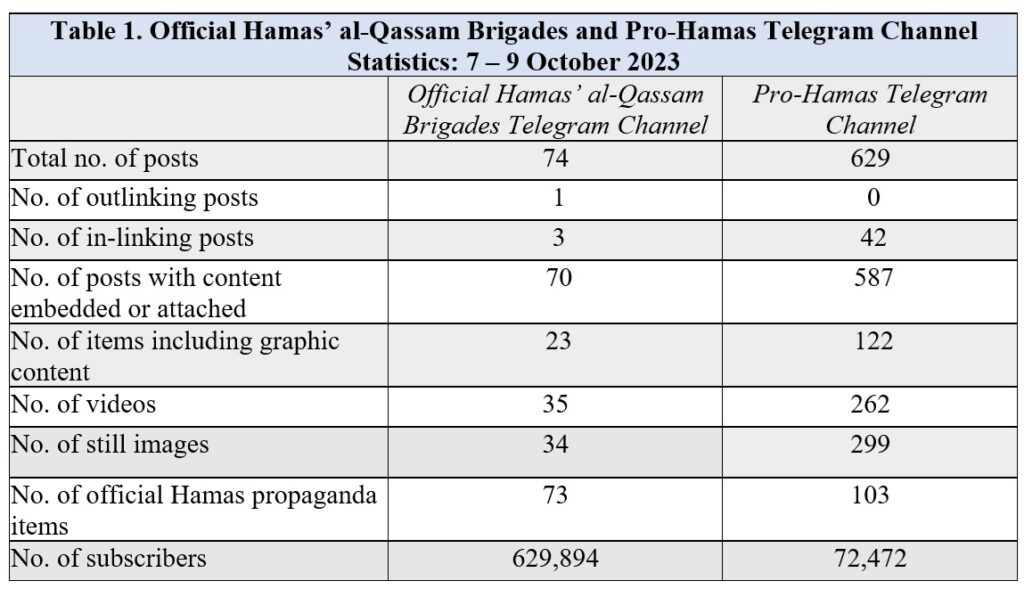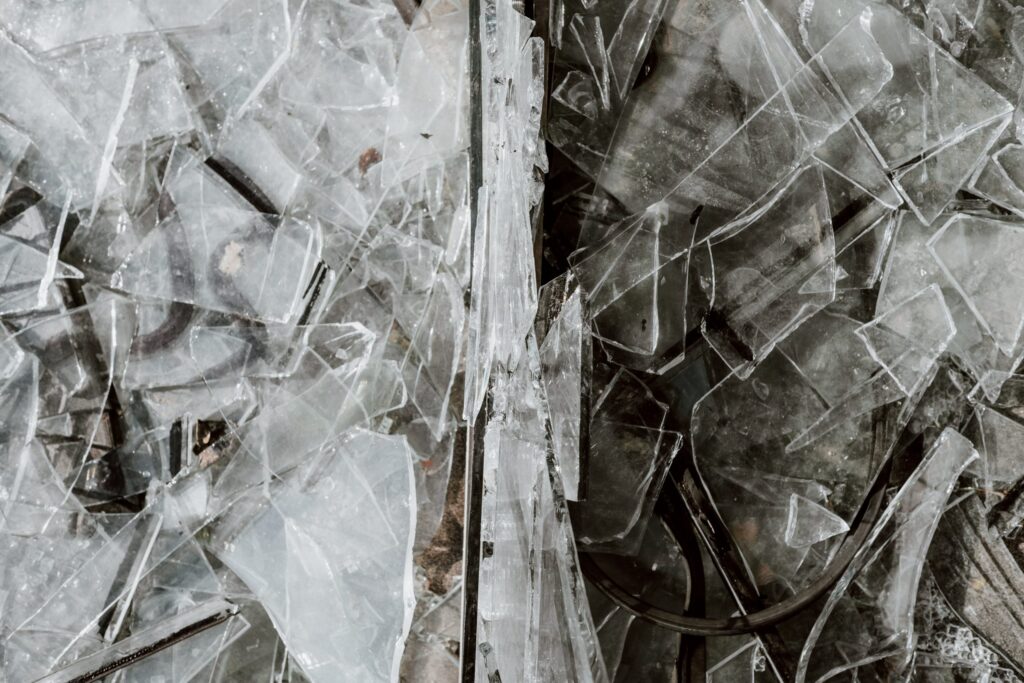By Sean McCafferty & Kamil Yilmaz
This analysis is Part 2 of a two-part post. Both are based on data gathered between 7 October and 9 October 2023 from two Telegram channels sharing propaganda related to the unfolding violence in Israel and Palestine: an official Telegram channel of the al-Qassam Brigades and an unofficial pro-Hamas Telegram channel (see Table 1). The first post focused on the increases in activity levels in the studied channels and concomitant increase in subscriber numbers in the three days post-attack. This post focuses on the nature of the content shared in the same period.

Comparison of Content
Hamas’ al-Qassam Brigades
At 7:14:am (IDT) on 7 October, a message was posted in Arabic to a Telegram channel assessed to be an official outlet of the al-Qassam Brigades. The message read: “Shortly. The Chief of Staff of the Qassam Brigades, Muhammad Al-Deif ‘Abu Khaled,’ delivers an important statement to the Palestinian people and the Arab and Islamic Nation.”
Following this message, highly produced and prepared videos of the initial phases of the attack, pre-attack training, and Hamas spokesmen’s speeches were shared. This burst of pre-prepared propaganda was accompanied by a photoset of images taken by al-Qassam Brigade fighters documenting the Israeli dead resulting from the initial attack.
During the data collection period (i.e., 7 – 9 October), the official al-Qassam Brigades Telegram channel largely disseminated carefully curated messages and updates about the attacks, alongside graphic images and videos of Israeli military dead.
Across the three-day sample, five of the videos shared were official statements of al-Qassam Brigades spokespersons. These statements provided justification for and updates on the attacks. Three in-links led to a separate Telegram channel of an al-Qassam Brigade spokesperson.
Among the 35 videos disseminated in the channel were several highly rehearsed videos of al-Qassam Brigade militants training in preparation for the attacks. These videos have been extensively analysed and demonstrate the capabilities of Hamas in preparation for the attacks including the use of gliders, kamikaze drones, and rockets.
The format of propaganda related to the attack followed a unique pattern, with highly rehearsed and professionally produced multi-media content disseminated alongside shaky perpetrator mobile phone footage.
Only one video assessed to be bystander footage was shared by the official al-Qassam channel as opposed to 73 items of officially branded content. This bystander footage was claimed to be of the aftermath of Hamas missile strikes in Israel captioned: “The effects of the Qassami bombing of Tel Aviv a short while ago.”
Pro-Hamas Telegram Channel
The pro-Hamas Telegram channel studied shared a broader range of content and propaganda than the official al-Qassam Brigade channel, including a large quantity of bystander footage, international news coverage, and propaganda from the al-Quds Brigades (AQB), the armed wing of Palestinian Islamic Jihad.
The pro-Hamas channel used this wider range of content to leverage a variety of narratives. The channel disseminated bystander footage, unverified images, and unclear sources. As a result, it is likely that misinformation, widely documented across the weekend,8 was shared within this channel across the course of the three-day sample.
The Hamas supporter channel drew on a wide range of sources related to the conflict, including reporting from Israeli sources and Hebrew language news reporting to document developments in the conflict. Several uses of Hebrew language sources and Israeli reporting were in relation to the taking of hostages.
Hostage taking has a long history in the conflict and has been a highly sensitive and particularly impactful issue for the Israeli state. The number of hostages taken on 7 October was the highest ever taken by Hamas and represents an important component of the terror of the attacks. The distribution in the Hamas supporter channel of hostage-related Hebrew language content appeared to be for purposes of underlining the psychological impact that hostage taking has on the Israeli public and government.
Graphic images, often taken by attack perpetrators, were shared extensively across the three-day period. The official al-Qassam Brigade channel distributed 23 graphic videos and images in the three days following the attacks. The focus was on videos taken by al-Qassam Brigade fighters of the aftermath of firefights with Israeli security forces at the Erez, Ra’im, and Kfar Azza sites.
Much of the footage taken by perpetrators on mobile phones had official branding; however, the most violent parts of the same footage, which was available elsewhere online, was often edited out of the versions shared by the al-Qassam Brigade channel. Notably no images of civilians killed in the Hamas attacks were shared via this channel either.
In several cases graphic sections of images were blurred when shared in the official al-Qassam Brigades channel. However, the application of blurring was not consistent, and several distributed items were highly graphic.
The pro-Hamas Telegram channel shared considerably more graphic content than the official channel in the same period. These 122 items of content included both officially branded graphic content mentioned above, along with extensive images and videos of both civilian and military dead from other sources. Graphic images and videos shared in the pro-Hamas channel were assessed to feature more disturbing content, including extensive desecration of corpses.
A large amount of the images and videos shared in the Telegram channels studied between 7-9 October appears to have been taken on mobile phones, by either attack perpetrators or bystanders, including both Israeli and Palestinian civilians. In contrast to the official al-Qassam Brigades channel, the pro-Hamas Telegram channel shared a large quantity of graphic images and videos of dead Israeli civilians.
The pro-Hamas channel also shared graphic images of dead Hamas fighters, Hamas militants’ martyrdom messages, and images of wounded and dead Palestinian civilians as the Israeli military response began to target Gaza. The contrasting use of these graphic images gives us insight into the propaganda value attributed to both images of Israeli and Palestinian dead.
For example, images of Israeli military and civilian dead were highly celebrated in the Hamas supporter channel, with videos of corpses being desecrated and stamped on shared as celebrations. As the aftermath of 7 October progressed, graphic images of Israeli airstrikes and the resulting casualties in Gaza began to be shared alongside martyrdom messages. These images appear to have been shared to illustrate the brutality of the Israeli response in order to support a narrative justifying the earlier attacks.
Graphic images played an important role in both channels and are at the centre of updates on the violence. Overall, the quantity of graphic content and its celebration in the pro-Hamas channel is distinct from the more carefully managed posting of graphic content in the al-Qassam Brigades channel, most importantly in the sharing of images of dead Israeli civilians.
The branding of perpetrator footage with the al-Qassam Brigades banner was an important aspect of propaganda dissemination as the violence unfolded. Both the amateur nature of much of that footage and its subsequent branding lent the photosets and videos an authenticity and authority as visceral and viral evidence of the extent of Hamas violence.
Conclusion
The pro-Hamas channel featured a wider array of unverified sources, including bystander footage, perpetrator footage, and international news coverage. This approach allowed for the rapid spread of information, while likely leading to the sharing of misinformation too.
In contrast, the official al-Qassam Brigades channel primarily shared carefully curated and branded propaganda content, focusing on official messaging, highly produced pre-prepared propaganda, and graphic images of Israeli military casualties.
Third, both channels heavily relied on images and videos taken by attack perpetrators. The official channel selectively shared perpetrator footage that included only Israeli military casualties, while the pro-Hamas channel included graphic images of both Israeli civilians and military casualties including a wide range of disturbing graphic content. This stark contrast in the use of graphic perpetrator content reflects the different narratives each channel sought to promote.
This work was supported by the Tech Against Terrorism Europe project, funded by the EU’s Internal Security Fund (Project 101080101).
Sean McCafferty is a research assistant at Dublin City University. Sean is a graduate from the Erasmus Mundus International Master’s in Security, Intelligence and Strategic Studies at Glasgow University, Dublin City University and Charles University. His research focuses on open-source intelligence, terrorism, propaganda, and technology. Twitter: @SeanRMcCafferty
Dr. Yilmaz currently works as a post-doctoral researcher at the Cyber Threats Research Centre (CyTREC), Swansea University in the UK. He is interested in Computational Social Science and his research interests include political violence, anthropology of terrorism, radicalization and deradicalization processes related to terrorism, terrorists’ use of social media and malign influence operations.
Image credit: PEXELS
Want to submit a blog post? Click here.
